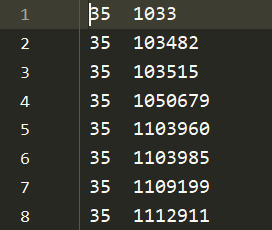数据集概括
Cora数据集由机器学习论文组成。 这些论文分为以下七个类别之一:
- 基于案例
- 遗传算法
- 神经网络
- 概率方法
- 强化学习
- 规则学习
- 理论
这些论文的选择方式是,在最终语料库中,每篇论文引用或被至少一篇其他论文引用。整个语料库中有 2708篇 论文。
在词干堵塞和去除词尾后,只剩下 1433个 唯一的单词。文档频率小于10的所有单词都被删除。
数据集文件说明
该数据集由 cora.cites 与 cora.content 两个文件组成。
cora.content
.content文件包含以下格式的论文描述:<paper_id> <word_attributes>+ <class_label>
每行(其实就是图的一个节点)的第一个字段是论文的唯一字符串标识,后跟 1433 个字段(取值为二进制值),表示1433个词汇中的每个单词在文章中是存在(由1表示)还是不存在(由0表示)。最后,该行的最后一个字段表示论文的类别标签(7个)。因此该数据的特征应该有 1433 个维度,另外加上第一个字段 idx,最后一个字段 label, 一共有 1433 + 2 个维度。

cora.cites
.cites文件包含语料库的引用关系‘图’。
每行(其实就是图的一条边)用以下格式描述一个引用关系:<被引论文编号> <引论文编号>
每行包含两个paper id。第一个字段是被引用论文的标识,第二个字段代表引用的论文。引用关系的方向是从右向左。如果一行由“论文1 论文2”表示,则“论文2 引用 论文1”,即链接是“论文2 – >论文1”。可以通过论文之间的链接(引用)关系建立邻接矩阵adj。

ind.cora.x : 训练集节点特征向量,保存对象为:scipy.sparse.csr.csr_matrix,实际展开后大小为: (140, 1433)
ind.cora.tx : 测试集节点特征向量,保存对象为:scipy.sparse.csr.csr_matrix,实际展开后大小为: (1000, 1433)
ind.cora.allx : 包含有标签和无标签的训练节点特征向量,保存对象为:scipy.sparse.csr.csr_matrix,实际展开后大小为:(1708, 1433),可以理解为除测试集以外的其他节点特征集合,训练集是它的子集
ind.cora.y : one-hot表示的训练节点的标签,保存对象为:numpy.ndarray
ind.cora.ty : one-hot表示的测试节点的标签,保存对象为:numpy.ndarray
ind.cora.ally : one-hot表示的ind.cora.allx对应的标签,保存对象为:numpy.ndarray
ind.cora.graph : 保存节点之间边的信息,保存格式为:{ index : [ index_of_neighbor_nodes ] }
ind.cora.test.index : 保存测试集节点的索引,保存对象为:List,用于后面的归纳学习设置。
import numpy as np
import pickle as pkl
import networkx as nx
import scipy.sparse as sp
# from scipy.sparse.linalg.eigen.arpack import eigsh 不知道为什么这个报错
from scipy.sparse.linalg.eigen import arpack
import sys
def parse_index_file(filename):
"""Parse index file."""
index = []
for line in open(filename):
index.append(int(line.strip()))
return index
def sample_mask(idx, l):
"""Create mask."""
mask = np.zeros(l)
mask[idx] = 1
return np.array(mask, dtype=np.bool)
def load_data(dataset_str):
"""
Loads input data from gcn/data directory
ind.dataset_str.x => the feature vectors of the training instances as scipy.sparse.csr.csr_matrix object;
ind.dataset_str.tx => the feature vectors of the test instances as scipy.sparse.csr.csr_matrix object;
ind.dataset_str.allx => the feature vectors of both labeled and unlabeled training instances
(a superset of ind.dataset_str.x) as scipy.sparse.csr.csr_matrix object;
ind.dataset_str.y => the one-hot labels of the labeled training instances as numpy.ndarray object;
ind.dataset_str.ty => the one-hot labels of the test instances as numpy.ndarray object;
ind.dataset_str.ally => the labels for instances in ind.dataset_str.allx as numpy.ndarray object;
ind.dataset_str.graph => a dict in the format {index: [index_of_neighbor_nodes]} as collections.defaultdict
object;
ind.dataset_str.test.index => the indices of test instances in graph, for the inductive setting as list object.
All objects above must be saved using python pickle module.
:param dataset_str: Dataset name
:return: All data input files loaded (as well the training/test data).
"""
names = ['x', 'y', 'tx', 'ty', 'allx', 'ally', 'graph']
objects = []
for i in range(len(names)): # 分别读取文件
with open("data/ind.{}.{}".format(dataset_str, names[i]), 'rb') as f:
if sys.version_info > (3, 0): # python版本大于3.0
data = pkl.load(f, encoding='latin1')
if (names[i].find('graph') == -1): # 如果不是.graph文件
print(f)
"""
x:(140, 1433) 140个节点参与训练,每个节点的向量为1433维度
y:(140,7) 140个参与训练的节点的训练目标,7维的独热编码
tx:(1000, 1433) 1000个参与测试的节点
ty:(1000, 7)
allx: (1708, 1433)
ally: (1708, 7)
"""
print(data.shape)
print(type(data))
# >>> <class 'scipy.sparse._csr.csr_matrix'>
print(type(data[0]))
# >>> <class 'scipy.sparse._csr.csr_matrix'>
for j in range(data.shape[0]): # 矩阵的行数
"""
#x: data[j]第j个节点的向量表示
#y: data[j]第j个节点的标签 y j (7,)
"""
print('********', names[i], j, data[j].shape, '**********')
print(data[j])
print('\n')
else:
print(f)
print(type(data))
# >>> <class 'collections.defaultdict'>
print(data)
objects.append(data)
else:
objects.append(pkl.load(f))
x, y, tx, ty, allx, ally, graph = tuple(objects)
# 训练数据集
print(x[0][0], x.shape, type(x)) ##x是一个稀疏矩阵,记住1的位置,140个实例,每个实例的特征向量维度是1433 (140,1433)
print(y[0], y.shape) ##y是标签向量,7分类,140个实例 (140,7)
##测试数据集
print(tx[0][0], tx.shape, type(tx)) ##tx是一个稀疏矩阵,1000个实例,每个实例的特征向量维度是1433 (1000,1433)
print(ty[0], ty.shape) ##y是标签向量,7分类,1000个实例 (1000,7)
##allx,ally和上面的形式一致
print(allx[0][0], allx.shape, type(allx)) ##tx是一个稀疏矩阵,1708个实例,每个实例的特征向量维度是1433 (1708,1433)
print(ally[0], ally.shape) ##y是标签向量,7分类,1708个实例 (1708,7)
##graph是一个字典,大图总共2708个节点
for i in graph:
print(i, graph[i])
#dataset_str:core数据集,format: 函数与参数结合使用,{}里面的内容将会被format()里面的参数替换
#获取text.index里面所有的数据
test_idx_reorder = parse_index_file("data/ind.{}.test.index".format(dataset_str))
test_idx_range = np.sort(test_idx_reorder)
print(test_idx_range.size)
print(type(test_idx_range))
print(test_idx_range)
if dataset_str == 'citeseer':
# Fix citeseer dataset (there are some isolated nodes in the graph)
# Find isolated nodes, add them as zero-vecs into the right position
test_idx_range_full = range(min(test_idx_reorder), max(test_idx_reorder) + 1)
tx_extended = sp.lil_matrix((len(test_idx_range_full), x.shape[1]))
tx_extended[test_idx_range - min(test_idx_range), :] = tx
tx = tx_extended
ty_extended = np.zeros((len(test_idx_range_full), y.shape[1]))
ty_extended[test_idx_range - min(test_idx_range), :] = ty
ty = ty_extended
features = sp.vstack((allx, tx)).tolil()
features[test_idx_reorder, :] = features[test_idx_range, :]
adj = nx.adjacency_matrix(nx.from_dict_of_lists(graph))
# print(adj,adj.shape)
labels = np.vstack((ally, ty))
labels[test_idx_reorder, :] = labels[test_idx_range, :]
idx_test = test_idx_range.tolist()
idx_train = range(len(y))
idx_val = range(len(y), len(y) + 500)
train_mask = sample_mask(idx_train, labels.shape[0])
val_mask = sample_mask(idx_val, labels.shape[0])
test_mask = sample_mask(idx_test, labels.shape[0])
y_train = np.zeros(labels.shape)
y_val = np.zeros(labels.shape)
y_test = np.zeros(labels.shape)
y_train[train_mask, :] = labels[train_mask, :]
y_val[val_mask, :] = labels[val_mask, :]
y_test[test_mask, :] = labels[test_mask, :]
return adj, features, y_train, y_val, y_test, train_mask, val_mask, test_mask
def sparse_to_tuple(sparse_mx):
"""Convert sparse matrix to tuple representation."""
def to_tuple(mx):
if not sp.isspmatrix_coo(mx):
mx = mx.tocoo()
coords = np.vstack((mx.row, mx.col)).transpose()
values = mx.data
shape = mx.shape
return coords, values, shape
if isinstance(sparse_mx, list):
for i in range(len(sparse_mx)):
sparse_mx[i] = to_tuple(sparse_mx[i])
else:
sparse_mx = to_tuple(sparse_mx)
return sparse_mx
def preprocess_features(features):
"""Row-normalize feature matrix and convert to tuple representation"""
rowsum = np.array(features.sum(1))
r_inv = np.power(rowsum, -1).flatten()
r_inv[np.isinf(r_inv)] = 0.
r_mat_inv = sp.diags(r_inv)
features = r_mat_inv.dot(features)
return sparse_to_tuple(features)
def normalize_adj(adj):
"""Symmetrically normalize adjacency matrix."""
adj = sp.coo_matrix(adj)
rowsum = np.array(adj.sum(1))
d_inv_sqrt = np.power(rowsum, -0.5).flatten()
d_inv_sqrt[np.isinf(d_inv_sqrt)] = 0.
d_mat_inv_sqrt = sp.diags(d_inv_sqrt)
return adj.dot(d_mat_inv_sqrt).transpose().dot(d_mat_inv_sqrt).tocoo()
def preprocess_adj(adj):
"""Preprocessing of adjacency matrix for simple GCN model and conversion to tuple representation."""
adj_normalized = normalize_adj(adj + sp.eye(adj.shape[0]))
return sparse_to_tuple(adj_normalized)
def construct_feed_dict(features, support, labels, labels_mask, placeholders):
"""Construct feed dictionary."""
feed_dict = dict()
feed_dict.update({placeholders['labels']: labels})
feed_dict.update({placeholders['labels_mask']: labels_mask})
feed_dict.update({placeholders['features']: features})
feed_dict.update({placeholders['support'][i]: support[i] for i in range(len(support))})
feed_dict.update({placeholders['num_features_nonzero']: features[1].shape})
return feed_dict
def chebyshev_polynomials(adj, k):
"""Calculate Chebyshev polynomials up to order k. Return a list of sparse matrices (tuple representation)."""
print("Calculating Chebyshev polynomials up to order {}...".format(k))
adj_normalized = normalize_adj(adj)
laplacian = sp.eye(adj.shape[0]) - adj_normalized
largest_eigval, _ = eigsh(laplacian, 1, which='LM')
scaled_laplacian = (2. / largest_eigval[0]) * laplacian - sp.eye(adj.shape[0])
t_k = list()
t_k.append(sp.eye(adj.shape[0]))
t_k.append(scaled_laplacian)
def chebyshev_recurrence(t_k_minus_one, t_k_minus_two, scaled_lap):
s_lap = sp.csr_matrix(scaled_lap, copy=True)
return 2 * s_lap.dot(t_k_minus_one) - t_k_minus_two
for i in range(2, k + 1):
t_k.append(chebyshev_recurrence(t_k[-1], t_k[-2], scaled_laplacian))
return sparse_to_tuple(t_k)
load_data('cora')